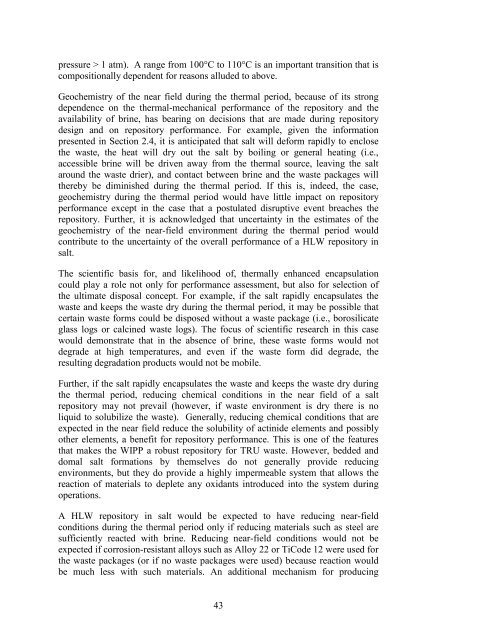Salt Disposal of Heat-Generating Nuclear Waste
Salt Disposal of Heat-Generating Nuclear Waste
Salt Disposal of Heat-Generating Nuclear Waste
Create successful ePaper yourself
Turn your PDF publications into a flip-book with our unique Google optimized e-Paper software.
pressure > 1 atm). A range from 100°C to 110°C is an important transition that is<br />
compositionally dependent for reasons alluded to above.<br />
Geochemistry <strong>of</strong> the near field during the thermal period, because <strong>of</strong> its strong<br />
dependence on the thermal-mechanical performance <strong>of</strong> the repository and the<br />
availability <strong>of</strong> brine, has bearing on decisions that are made during repository<br />
design and on repository performance. For example, given the information<br />
presented in Section 2.4, it is anticipated that salt will deform rapidly to enclose<br />
the waste, the heat will dry out the salt by boiling or general heating (i.e.,<br />
accessible brine will be driven away from the thermal source, leaving the salt<br />
around the waste drier), and contact between brine and the waste packages will<br />
thereby be diminished during the thermal period. If this is, indeed, the case,<br />
geochemistry during the thermal period would have little impact on repository<br />
performance except in the case that a postulated disruptive event breaches the<br />
repository. Further, it is acknowledged that uncertainty in the estimates <strong>of</strong> the<br />
geochemistry <strong>of</strong> the near-field environment during the thermal period would<br />
contribute to the uncertainty <strong>of</strong> the overall performance <strong>of</strong> a HLW repository in<br />
salt.<br />
The scientific basis for, and likelihood <strong>of</strong>, thermally enhanced encapsulation<br />
could play a role not only for performance assessment, but also for selection <strong>of</strong><br />
the ultimate disposal concept. For example, if the salt rapidly encapsulates the<br />
waste and keeps the waste dry during the thermal period, it may be possible that<br />
certain waste forms could be disposed without a waste package (i.e., borosilicate<br />
glass logs or calcined waste logs). The focus <strong>of</strong> scientific research in this case<br />
would demonstrate that in the absence <strong>of</strong> brine, these waste forms would not<br />
degrade at high temperatures, and even if the waste form did degrade, the<br />
resulting degradation products would not be mobile.<br />
Further, if the salt rapidly encapsulates the waste and keeps the waste dry during<br />
the thermal period, reducing chemical conditions in the near field <strong>of</strong> a salt<br />
repository may not prevail (however, if waste environment is dry there is no<br />
liquid to solubilize the waste). Generally, reducing chemical conditions that are<br />
expected in the near field reduce the solubility <strong>of</strong> actinide elements and possibly<br />
other elements, a benefit for repository performance. This is one <strong>of</strong> the features<br />
that makes the WIPP a robust repository for TRU waste. However, bedded and<br />
domal salt formations by themselves do not generally provide reducing<br />
environments, but they do provide a highly impermeable system that allows the<br />
reaction <strong>of</strong> materials to deplete any oxidants introduced into the system during<br />
operations.<br />
A HLW repository in salt would be expected to have reducing near-field<br />
conditions during the thermal period only if reducing materials such as steel are<br />
sufficiently reacted with brine. Reducing near-field conditions would not be<br />
expected if corrosion-resistant alloys such as Alloy 22 or TiCode 12 were used for<br />
the waste packages (or if no waste packages were used) because reaction would<br />
be much less with such materials. An additional mechanism for producing<br />
43
















